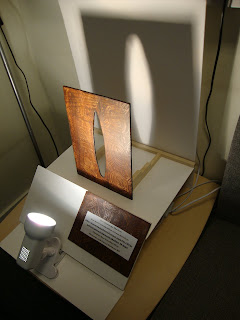The task was to produce any material or digital form engaging to any relevant topic that could insight anthropological methods within the design processes. The Tjurunga Shadow Exhibition was a result of the alignments of different segments of thoughts and different perspectives on different realities.
The Tjurunga’s mythology and secrecy is present within Western society and exists among the Aboriginal people. The Tjurunga is an artefact of spiritual significance among the Arrunta people, from central Australian territory (Spencer and Gillen, 1927). The artefact is commonly made of stone or wood and might and could be painted with ochre dye or different types of natural dye found locally. The Tjurunga is considered a highly sacred object, for its capacity of embodiment of ancient Aborigines traditions. The object is used as a tool during spiritual rites being only handled by initiated people (Spencer and Gillen, 1927). Since it embodies sacred values, it is a social taboo not only to display the object but also to display pictures of the Tjurunga (Ibid).Therefore the popular social visual existence of this artefact exists only as a “spiritual” being rather than as a material and physical artefact. Aboriginal communities believe that some traditional objects contain a soul, just as humans, and this soul may be harmed by misuse of the cultural rules and beliefs (ibid).
This was a practical project made for the Material and Visual Culture MA at the Anthropology Department at UCL in May 2011.
In an attempt to drive away from the Imperialistic unbalanced overpower, it is necessary to face ethical dilemmas within museum culture of display. This project was an attempted though to emphasise values which exists among the source community, overcoming museum culture through display of power (Merrill, and Ahlborn 1997). The Tjurunga Shadow was an attempt to find a “middle way”, as a solution for museum culture and Aborigines traditions’ overcome paradoxical dilemma of existence.
The idea was to display its concepts which might be taken from perspectives on the subjectivity observed and absorbed within the source community (Ibid). The goal was to display a representation of a social being, which could relate to the material being only through the representation of some relevant values. It was found relevant to emphasise the different perspective which the Australian Aborigines community relate to some of their artefacts. There might be an enormous contrast with Western's semiotics values: which may be perceived by critics, as obsessed with semiotics and the Western aesthetical value model (Mowaljarlai and Vinnicombe, et al. 1988) ; far different from the highly spiritual considerations which are important to Aboriginal people. Although, the representation created to substitute a vulgar display of power was achieved, the making of the imagined artefact might have fail to avoid Western’s aesthetics values.
The object of choice could vary in infinite ways but the curator's choice of object for display has been based in various concepts some related above and some others that I will relate know. One of the concepts considered was the subject-object relation and Gell's (1998) ideas relating to Anthropology of Art. Subject and its intentionally might become the object of the observer. The intentionality and subjectivity of the Tjurunga is the object ive shadow, which is displayed and observed by audiences. There is in fact no object displayed, but instead, the emptiness of the object which attempt to transmit and embody Australian Aboriginal secret spiritual believes and myths. The medium for such accomplishment was a negative plate of the supposed shape of the Tjurunga .and a lamp with a spot light that draws the shape in form of light in the back structure of the white display.
Another concepts embraced was Latour's (1991) Actor-network Theory in which subject-object relations are constantly transformed by programmes and anti-programmes translated and dislocated within different hybrid realities. This idea was used on the Tjurunga Shadow Exhibition by the usage of different spaces and time, by display: on UCL Anthropology Department at the student common room and on the internet blog space creating different localities, different relations and different interaction and reactions. The result was the usage of the digital media, allowing the possibility of connecting the material world and the audiences through different technological platforms, such as through your iMac, iPhone, Blackberry or Smartphone.
The following pictures have been taken after the installation of the display in the designated space at our department.
Bibliography
· Gell, A. (1988). Technology and Magic. In: Anthropology Today, 2(4), p 6-9.
· Latour, B. (1991). Technology is society made durable. In: Law, J A Sociology of Monsters. London: Routledge.
· Merrill, W. and Ahlborn R. (1997). Zuni archangels and Ahayuda: A sculpture chronicle of power and identity. In: Henderson, A. and Kaeppler, A. Exhibiting dilemmas: Issues of representation at the Smithsonian. Washington D.C.: Smithsonian Institution, p 176-205.
· Mowaljarlai, D. and Vinnicombe, P. et al. (1988). Repainting of images on rock in Australia and the maintenance of Aboriginal culture. Antiquity. 62(237), p 690-696.
· Spencer, B. and Gillen, F.J. (1927). The Arunta: a study of a Stone Age people. 2nd ed. London: Macmillan.







